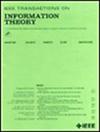双成分线性回归混合物 EM 算法的全局最优性
IF 2.2
3区 计算机科学
Q3 COMPUTER SCIENCE, INFORMATION SYSTEMS
引用次数: 0
摘要
最近的研究结果表明,EM 对高斯混合模型具有全局收敛性。然而,对于混合线性回归,目前只确定了局部收敛结果,而且只针对高信噪比(SNR)机制。在这项工作中,我们完全描述了 EM 的全局最优性:我们证明了从任意随机初始化点开始,EM 算法在所有信噪比条件下都能以最小统计率收敛到真实参数 ${beta }^{*}$。为了实现这一目标,我们首先展示了 EM 算法在群体水平上的全局收敛性。然后,我们提供了有限样本下 EM 在所有信噪比情况下的统计和计算行为的完整特征。具体而言:(i) 当信噪比足够大时,经过 $O(\log (n/d))$ 次迭代后,EM 更新以标准参数收敛速率 $O((d/n)^{1/2})$收敛到真实参数 $ {\beta }^{*}$。(ii) 在信噪比高于 $O((d/n)^{1/4})$且低于某个常数的情况下,当迭代次数为 $O({\mathrm { SNR}}^{-2} \log (n/d))$ 时,EM 迭代收敛到真实参数的 $O({\mathrm { SNR}}^{-1} (d/n)^{1/2})$ 邻域。(iii) 在信噪比低于 $O((d/n)^{1/4})$的低信噪比条件下,我们证明 EM 在经过 $O((n/d)^{1/2})$迭代后,会收敛到真实参数的 $O((d/n)^{1/4})$邻域。通过提供 EM 算法在中低信噪比条件下的严格收敛保证,我们揭示了在低信噪比条件下,EM 的速率会发生变化,与 MLE 的 $n^{-1/4}$ 速率相匹配,这是以前的工作无法显示的。本文章由计算机程序翻译,如有差异,请以英文原文为准。
Global Optimality of the EM Algorithm for Mixtures of Two-Component Linear Regressions
Recent results established that EM enjoys global convergence for Gaussian Mixture Models. For Mixed Linear Regression, however, only local convergence results have been established, and those only for the high signal-to-noise ratio (SNR) regime. In this work, we completely characterize the global optimality of EM: we show that starting from any randomly initialized point, the EM algorithm converges to the true parameter
${\beta }^{*}$
at the minimax statistical rates under all SNR regimes. Toward this goal, we first show the global convergence of the EM algorithm at the population level. Then we provide a complete characterization of statistical and computational behaviors of EM under all SNR regimes with finite samples. In particular: (i) When the SNR is sufficiently large, the EM updates converge to the true parameter
$ {\beta }^{*}$
at the standard parametric convergence rate
$O((d/n)^{1/2})$
after
$O(\log (n/d))$
iterations. (ii) In the regime where the SNR is above
$O((d/n)^{1/4})$
and below some constant, the EM iterates converge to a
$O({\mathrm { SNR}}^{-1} (d/n)^{1/2})$
neighborhood of the true parameter, when the number of iterations is of the order
$O({\mathrm { SNR}}^{-2} \log (n/d))$
. (iii) In the low SNR regime where the SNR is below
$O((d/n)^{1/4})$
, we show that EM converges to a
$O((d/n)^{1/4})$
neighborhood of the true parameters, after
$O((n/d)^{1/2})$
iterations. By providing tight convergence guarantees of the EM algorithm in middle-to-low SNR regimes, we reveal that in low SNR, EM changes rate, matching the
$n^{-1/4}$
rate of the MLE, a behavior that previous work had been unable to show.
求助全文
通过发布文献求助,成功后即可免费获取论文全文。
去求助
来源期刊

IEEE Transactions on Information Theory
工程技术-工程:电子与电气
CiteScore
5.70
自引率
20.00%
发文量
514
审稿时长
12 months
期刊介绍:
The IEEE Transactions on Information Theory is a journal that publishes theoretical and experimental papers concerned with the transmission, processing, and utilization of information. The boundaries of acceptable subject matter are intentionally not sharply delimited. Rather, it is hoped that as the focus of research activity changes, a flexible policy will permit this Transactions to follow suit. Current appropriate topics are best reflected by recent Tables of Contents; they are summarized in the titles of editorial areas that appear on the inside front cover.
 求助内容:
求助内容: 应助结果提醒方式:
应助结果提醒方式:


